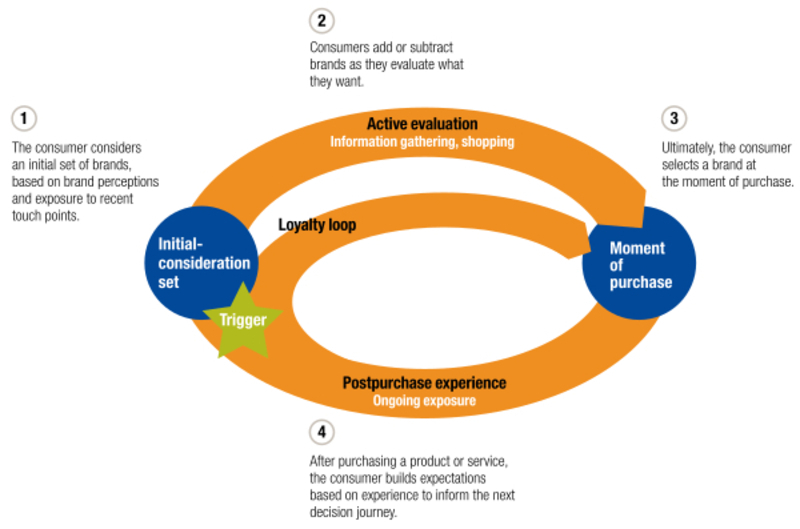Recap

In our previous blog, it was discussed that the affiliate market was traditionally based on last-click attribution. As consensus grows about the fact that this is not desirable, the dialogue on how to properly reward traffic sources continues. In this article we focus on how to reward affiliates while looking at the entire customer journey. Over the past years, attribution models have become popular tools to give advertisers insights into their affiliates’ contributions. However, these models work with fixed percentages to reward affiliates, which means that credit is based on a fixed model and affiliate’s incremental value is still ignored. In addition, these models are often limited to the affiliate channel only, neglecting other touch points in the customer journey.
The Customer Journey
By looking at the Consumer Decision Journey model (Mckinsey, 2015) we can gain a better understanding of why incremental value is important. Let’s take a look at the decision process a consumer typically goes through: In the first phase, the consumer considers an initial set of brands. Secondly, the consumer actively evaluates his initial choices, adding and subtracting brands. In the third phase, the consumer converts by making a purchase, and finally, the consumer builds expectations based on earlier experience to inform the next decision journey. The model below represents the decision making process.

Initial Consideration
Having a clear view on your customers’ decision making process is important because it will help understand the value of various touchpoints in a customer journey. There’s a clear distinction to be made between new and returning customers. Evidently, the initial consideration phase is what should be focused on for new customers. Customers in this phase find themselves still orientating towards potentially interesting products, creating a base for future decisions. The first touchpoint here is thus especially valuable, as it essentially initiates the customer journey. Therefore, the power of a traffic source lies in its ability to target a relevant new audience. Analyzing a large database of customer journeys, it’s possible to identify those touchpoints that send high quality traffic and have a high customer lifetime value. Hence, if acquiring new customers is important to you as an advertiser, first click plays a more important role here.
Returning Customers
On the contrary, the question arises if last click is actually closely associated with returning customers. Returning customers have passed the initial consideration phase and find themselves in the so-called loyalty loop. This means that instead of a convincing touchpoint, customers in this phase can convert by simply being triggered (by an e-mail or an offer for example). However, if a returning customer moves through various touchpoints before converting, does that mean last click was the most valuable touchpoint here? It might actually not, as all touchpoints in the customer journey somehow contributed to the conversion. So, while it’s clear that first click and new customers are closely associated, this effect is less pronounced for last click and returning customers. Perhaps, all touchpoints should be valued equally? Aside from these questions, strategic knowledge about the consumer decision making process is essential when making decisions related to attribution. Undoubtedly, this process works different for each organization and field. This is where the field expert comes in.
The Human Brain

As mentioned in our previous post, most popular attribution models don’t solve the problem of identifying and rewarding true incrementality for all affiliates. First of all, popular models work with fixed percentages to reward affiliates. Credit is based on a fixed model, which means an affiliate’s incremental value is not taken into consideration. Secondly, the data used for these models is likely to be incomplete, which means results are inaccurate. This is why the suggested commissions provided by attribution models/software should not be taken for granted. Humans still have an important advantage here, because a model will not give you all the information about how valuable a certain affiliate is at that point in time. However, humans are able to oversee the bigger picture, given they understand the customer’s decision making process and journey. Combine this unique human skill with data insights and you can make fair and solid decisions about affiliate rewardings.
